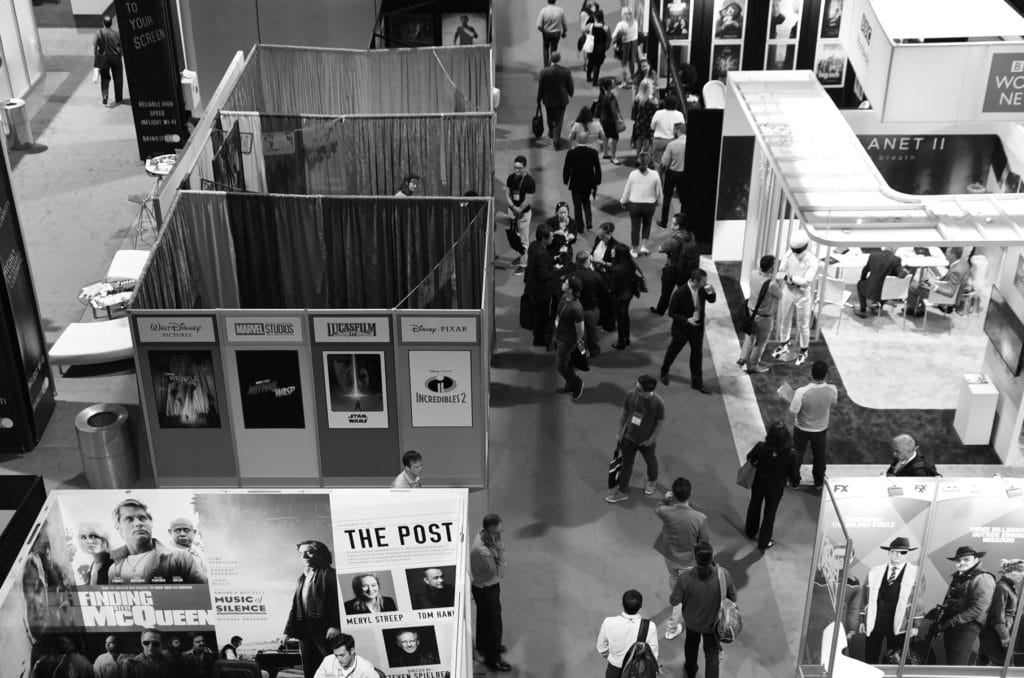The Logistics and Legacy of Navigating the Show Floor in the Early Days of EXPO
Share

Knowing how to score a meeting (or a minute for an elevator pitch) was as important then as it is now. Learn about the ins and outs of past show-floor logistics – and how today’s current set-up came to be.
More than 5,000 aviation professionals are expected to walk the APEX EXPO show floor this year. Register today!
In the early days, conferences began with a sign-up period during which vendors made appointments with airline delegates on what was known as a “dance card.” It was only in 1985, at the association’s first international conference in Munich, that this process took on a more official format, with vendors setting up tables and airlines circulating the room to fill up their dance cards with meetings for the days to come.
“We vigorously scheduled appointments on our dance cards and zealously kept our appointments despite the logistical hurdles,” Lufthansa’s Michael Manstein writes in Avion. “There was serious business to be conducted, and I think the airline people felt a special responsibility to see as many vendors as possible.” APEX Technology Committee member Rich Salter similarly recalls, “The dance card was a real ritual. Everyone carried their printed dance card in their pockets and never threw it out.”
“We vigorously scheduled appointments on our dance cards and zealously kept our appointments despite the logistical hurdles.” €” Michael Manstein, Lufthansa
There were no booths in the early days and, after being scheduled on dance cards, meetings would take place in hotel lobbies, suites or rooms. In one case, Global Eagle’s Steve Harvey remembers his girlfriend calling and his having to explain that he couldn’t talk because someone was in the room with him: “‘Male or female?’ she asked, and I said, ‘Don’t worry, darling. It’s strictly business. We’ll talk later.’ Then she called back and I said, ‘Can’t talk now, someone else is here.’ And she said, ‘What the heck is happening at this conference?'”
But nothing off-color was happening, assures Joe Barber, who worked at Cine Magnetics at the time. “When someone says ‘meetings in hotel rooms,’ it might conjure up mysterious things with people wheeling and dealing, but I don’t remember it being like that,” he says. “It was just easier to deal in that atmosphere. In certain cases, these weren’t even one-on-one meetings, but more like social affairs – cocktails being served and preview reels being shown.”
The bigger companies would book hotel suites for the duration of the event, using these to exhibit their products, rub elbows with potential clients and, in the evenings, host parties. At the very first conference, held at the International Hotel Resort in Palm Springs, two such suites were available and the two biggest companies attending the show (Inflight Services and Bell & Howell) had them booked for the duration of the event.
“They would let no one enter their sacred portals other than airlines for fear of the competition finding out what the other was presenting.” €” Cindy Tarver, AEA co-founder
“Under lock and key, those companies were showing the very latest in new, lightweight projector technology, and they would let no one enter their sacred portals other than airlines for fear of the competition finding out what the other was presenting,” recalls AEA co-founder Cindy Tarver in Avion.
Vendor booths in a ballroom setting made their first appearance at the 1988 conference in Miami, but they were of the draped variety, separated by waist-high barriers. “It wasn’t incredibly private, but at least it was a start, and it got us out of our hotel bedrooms,” Harvey says. Hard-wall booths were introduced the following year in Basel, Switzerland, and by the time the show got to London in 1991, “people began to make a splash with very flashy booths,” he says.
Once the conference and exhibition were brought together under one roof with the 1993 show in Palm Springs, exhibit stands began to be “built like walled fortresses with only one way in and out and a sentry at the gate,” former board member Jim Snyder writes in Avion. However, within about 10 years, booths became “more visually open” and no longer shrouded in secrecy, with competitors even being invited for a tour of (some) product demos, Snyder adds.
Make the most of your time at APEX EXPO with these expert networking tips.
Since the early ’90s, vendors also began to be identified with red badges and airlines with blue, with the latter being the primary targets at the shows. “Airline attendees will notice that exhibitors’ eyes often lock onto their blue badges, and those same exhibitors sometimes follow them down aisles… even into toilets,” reads a 2009 article in Avion. Touch Inflight’s Joe Carreira recalls these dynamics well from his time as both an airline attendee and supplier. “When I was a supplier, I had an airline delegate who would ask me if they could borrow my badge. I sympathized with them being badgered all the time, and I now try not to be too aggressive,” he says.
As for the dance card? The tradition ended in 1997, with telephone, fax and later e-mail rendering it obsolete.
“Navigating the Floor” was originally published as a sidebar to “Social Club” in the 9.4 September/October issue of APEX Experience magazine.


